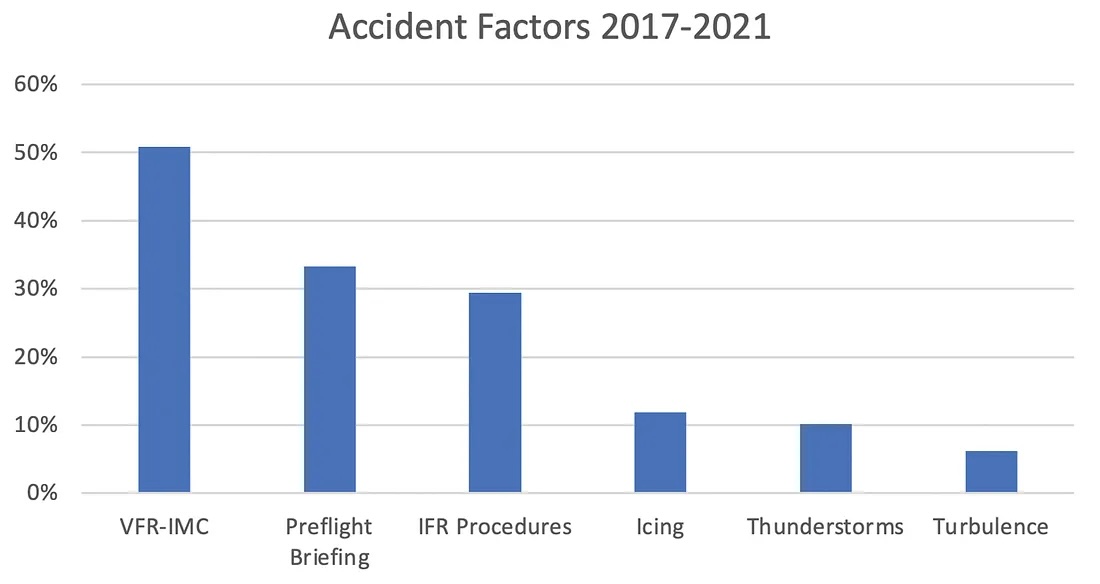By James Williams, FAA
What’s the scariest thing you’ve ever been through in an airplane? For me, pretty much every one of those stories involves weather. Even though my weather gambles paid off, they are still seared into my memory as moments where my life, and in my experiences, the lives of others, teetered on the edge of a knife. Those “good” outcomes rank among the most dangerous moments of my flying experience. That’s one of the reasons I’ve always had a particular interest in weather accidents and watching those trends over time. I’ve written numerous articles over the years on the topic, and my process has always involved reading through general aviation (GA) weather accident reports from the National Transportation Safety Board (NTSB). Reviewing individual reports gives me a feel for details that aren’t easily discernable with a simple numerical count. One trend I noticed declining in a recent data review was the number of pilots without instrument ratings who were filing and flying on IFR (instrument flight rules) flight plans. Let’s look at the numbers.
BY THE NUMBERS
For this article I reviewed accident data between 2017 and 2021. This yielded 177 accidents with 83% fatal and 321 lives lost. The rate hovered around 30 to 40 accidents per year, with 2017 being the highest (40) and 2018 being the lowest (29). Of these accidents, 75% resulted in loss of control (LOC) and 25% were controlled flight into terrain (CFIT) or obstacle strikes.
More than half of all the accidents I reviewed involved visual flight rules (VFR) operation into instrument metrological conditions (IMC), and a third of them involved a failure to prepare for the flight properly in terms of a weather briefing. More than a third of the pilots did not possess an instrument rating. Other weather-related factors, such as icing (12%), thunderstorms (10%), and turbulence (6%), were noteworthy but not a significant driving force. A larger area of concern was the 29% of accidents involving a failure to follow instrument procedures and air traffic control (ATC) instructions. The percentages don’t equal 100% as more than one factor may be involved in each accident.

THE DEVIL IN THE DETAILS
While it is time-consuming to skim more than 200 NTSB reports (there are more than a few accidents that were mechanical in nature and had to be excluded), it does give you an excellent feel for how these accidents are happening. As I mentioned earlier, a notable trend in prior decades saw a surprising number of non-instrument-rated pilots filing and flying IFR and ending up in an accident report. By the turn of the century, these incidents had all but disappeared. The failures to obtain a preflight briefing are more challenging to detect with the rise of a host of new resources not all of which track usage. But in many cases, we can tell either by conversations with friends, family, and bystanders or by other actions that the pilot was cognizant of the weather. So, the cited third of those accidents involving a failure to properly prepare for a flight only includes those who disregard the need for a weather briefing rather brazenly, meaning there is no record of any other corroborating evidence of weather awareness.
Speaking of brazen, there’s something I’ve noticed in the reports. There seems to be a growing trend of non-instrument-rated pilots who take off into IMC with no flight plan despite other pilots, friends/family, or airport denizens strongly urging them not to. In these cases, we know the pilot is well aware of the dangers. In one case that involved an airplane with multiple owners, the non-instrument-rated owner sought advice from an instrument-rated owner regarding the flight. The instrument-rated owner reviewed the planning and weather and told the accident pilot the flight could not be conducted under VFR. Unfortunately, he was right.

In another accident case, an aviation maintenance technician who had just completed repairs to the airplane strongly encouraged the pilot to delay his take-off as the field was experiencing low IMC. The pilot declined this advice and disappeared into the clouds just after lift-off, with fatal results a few minutes later. These aren’t cases where there’s even a chance of staying below the clouds or mistaking the conditions. I have not dug deeply enough to quantify whether this might be a few outliers presenting as a trend or something else entirely, but I will be taking a closer look at it in the future.
WHEN IN DOUBT
So, how do we address these issues? The first corrective action would be to step up your weather briefing skills. Review the checklist developed by Jeff Arnold in the article “Building Confidence with the Conditions” for more information on specific self-briefing advice.
But in more general terms, you need to emphasize weather briefings and make them more than just a box-checking exercise. While there were exceptions, overwhelmingly, the weather conditions that would prove fatal in so many cases were forecasted before the flight departed. One step that may help would be to use a weather log. This is a method of recording the contents of your briefing in an easy-to-reference format. By categorizing the weather, you force yourself to consider it more deeply than if you just scan the briefing page. You are also creating a record of the conditions that you found acceptable on launch to have something to compare to if you run into unforecasted conditions. Another solution is to crowd-source your decision-making.
It’s crucial to approach flying in the weather with the respect it’s due because when things go wrong, it can easily turn fatal.
With the rise of electronic communications, your briefing data is nothing more than a few virtual keystrokes to send your proposed flight’s weather log to a fellow pilot for a quick review. Ideally, this would be a mentor with more experience than you, but any other rated pilot still offers a huge benefit; they aren’t invested in making the flight. “Get-there-itis,” especially when combined with the sunk cost fallacy (I paid for a hotel/vacation), does a number on our decision-making capabilities. It’s still hard to combat even when we’re aware of it. Using a neutral party who doesn’t have that kind of investment is an excellent reality check. Another great benefit of using a weather log is the reminder that a go/no-go decision is a continuous process that can be reversed or amended if circumstances change. While a weather log gives you an excellent mechanism to fall back on, it isn’t required for you to reevaluate your decision. If you feel things aren’t going to plan, ask for help and turn around.
Another area of concern is instrument procedures and processes. The failure to follow these critical procedures has a few different causes but primarily boils down to a lack of IFR proficiency and task saturation during IMC. The ideal solution to these problems is more IFR practice in IMC with an instructor. However, both cost and practical considerations, like trying to schedule the weather, make that a challenge.
I’ve always advocated for simulation as an additional tool for this situation. Whether in a formalized environment like a flight school or even at home on a desktop computer, the ability to practice procedures without risk in an IMC environment is a big win. There are even services that employ air traffic controllers to guide you in the sim just as if they were working in an actual approach control environment. This gives you the chance to practice procedures and learn weaknesses in your IFR proficiency that you can work on with an instructor. It’s also an excellent chance to improve radio proficiency and get more comfortable working with controllers.
It’s crucial to approach flying in the weather with the respect it’s due because when things go wrong, it can easily turn fatal. But also, because many of these accidents are so easily avoided. Focus on knowing the conditions you’re expecting, and the capabilities of both you and your aircraft. And avoid thinking about the go/no-go decision as a singular point in time. You can always change your mind if things don’t seem to be going to plan.
Gambling can be a fun pastime in a casino, but you shouldn’t do it in an airplane when the odds are stacked against you. Instead, make your own luck and keep the odds in your favor by following the recommendations above.





